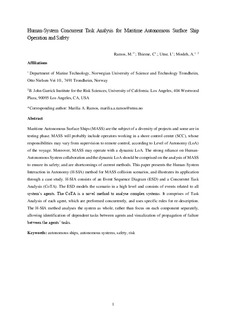| dc.contributor.author | Ramos, Marilia Abilio | |
| dc.contributor.author | Thieme, Christoph Alexander | |
| dc.contributor.author | Utne, Ingrid Bouwer | |
| dc.contributor.author | Mosleh, Ali | |
| dc.date.accessioned | 2019-11-08T10:00:37Z | |
| dc.date.available | 2019-11-08T10:00:37Z | |
| dc.date.created | 2019-11-07T11:36:35Z | |
| dc.date.issued | 2019 | |
| dc.identifier.citation | Reliability Engineering & System Safety. 2020, 195 (106697), . | nb_NO |
| dc.identifier.issn | 0951-8320 | |
| dc.identifier.uri | http://hdl.handle.net/11250/2627370 | |
| dc.description.abstract | Maritime Autonomous Surface Ships (MASS) are the subject of a diversity of projects and some are in testing phase. MASS will probably include operators working in a shore control center (SCC), whose responsibilities may from supervision to remote control, according to Level of Autonomy (LoA) of the voyage. Moreover, MASS may operate with a dynamic LoA. The strong reliance on Human-Autonomous System collaboration and the dynamic LoA should be comprised on the analysis of MASS to ensure its safety; and are shortcomings of current methods. This paper presents the Human-System Interaction in Autonomy (H-SIA) method for MASS collision scenarios, and illustrates its application through a case study. H-SIA consists of an Event Sequence Diagram (ESD) and a concurrent task analysis (CoTA). The ESD models the scenario in a high level and consists of events related to all system's agents. The CoTA is a novel method to analyse complex systems. It comprises of Task Analysis of each agent, which are preformed concurrently, and uses specific rules for re-description. The H-SIA method analyses the system as whole, rather than focus on each component separately, allowing identification of dependent tasks between agents and visualization of propagation of failure between the agents’ tasks. | nb_NO |
| dc.language.iso | eng | nb_NO |
| dc.publisher | Elsevier | nb_NO |
| dc.rights | Attribution-NonCommercial-NoDerivatives 4.0 Internasjonal | * |
| dc.rights.uri | http://creativecommons.org/licenses/by-nc-nd/4.0/deed.no | * |
| dc.subject | Sikkerhet | nb_NO |
| dc.subject | Safety | nb_NO |
| dc.title | Human-system concurrent task analysis for maritime autonomous surface ship operation and safety | nb_NO |
| dc.type | Journal article | nb_NO |
| dc.type | Peer reviewed | nb_NO |
| dc.description.version | acceptedVersion | nb_NO |
| dc.source.pagenumber | 21 | nb_NO |
| dc.source.volume | 195 | nb_NO |
| dc.source.journal | Reliability Engineering & System Safety | nb_NO |
| dc.source.issue | 106697 | nb_NO |
| dc.identifier.doi | https://doi.org/10.1016/j.ress.2019.106697 | |
| dc.identifier.cristin | 1744881 | |
| dc.relation.project | Norges forskningsråd: 274441 | nb_NO |
| dc.description.localcode | © 2019. This is the authors’ accepted and refereed manuscript to the article. Locked until 22.10.2021 due to copyright restrictions. This manuscript version is made available under the CC-BY-NC-ND 4.0 license http://creativecommons.org/licenses/by-nc-nd/4.0/ | nb_NO |
| cristin.unitcode | 194,64,20,0 | |
| cristin.unitname | Institutt for marin teknikk | |
| cristin.ispublished | true | |
| cristin.fulltext | original | |
| cristin.fulltext | preprint | |
| cristin.qualitycode | 2 | |

